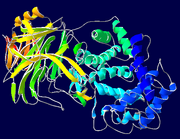IRVINE, Calif.--(BW HealthWire)--June 25, 1998--Advanced Corneal Systems, Inc. ("ACS") announced that clinical data presented at the 28th International Congress of Ophthalmology, held this week in Amsterdam, the Netherlands, supports the use of Vitrase(TM) as a treatment that can potentially induce clearing of vitreous hemorrhage safely and more frequently than when the hemorrhage is left to clear on its own.
The company and its clinical investigators presented final data from a Phase III study of the investigational drug, conducted in Mexico, as well as interim data from the company's Phase II study, conducted in the United States.
Vitreous hemorrhage, or bleeding into the back portion of the eye, clouds the sight of affected individuals and makes it difficult for the ophthalmologist to see through the hemorrhage to the retina to assess its status or treat the underlying problem. This condition can occur from a variety of causes, but most often is a complication of diabetes.
Results of the multi-center, Phase III study conducted in Mexico were presented by clinical investigators Fedrico Graue-Wiechers, M.D. and Marco A. De la Fuente Torres, M.D. of the Instituto de Oftalmologia, "Fundaciyn Conde de Valenciana," U.N.A.M. Mexico City.
The study, a prospective, randomized, double-masked, dose-response trial conducted in 225 patients who had experienced a vitreous hemorrhage for a minimum of one month, evaluated the safety and effectiveness of three doses of Vitrase (7.5 IU, 37.5 IU and 75 IU). The patients received Vitrase treatment as one 0.03cc intravitreal injection and follow-up exams were made at one and two days post-injection and then weekly until the hemorrhage cleared or up to eight weeks post-injection if the hemorrhage did not clear.
At all dose levels, treatment was well-tolerated and no serious, unexpected treatment-related adverse events were reported. Findings showed a significant difference in the incidence of vitreous hemorrhage clearance for patients with dense hemorrhages, with the highest proportion of dense hemorrhage clearance occurring in the 75 IU dose (62.7%; p=0.027).
ACS recently announced that, based in part on these Phase III results, a regulatory submission for marketing approval had been submitted to the National Ministry of Health of Mexico.
The company also discussed interim results from its Phase II trial of Vitrase conducted in the United States. This trial, which was also a prospective, randomized, double-masked, dose-response study in patients who had vitreous hemorrhage for at least one month, included 153 subjects enrolled at 21 centers.
The study design was the same as for the Mexican Phase III trial. Treatment was well tolerated by patients enrolled in all three dose groups, and the investigators reported no serious drug or study-related adverse events. Efficacy results for the incidence of hemorrhage clearing in patients with dense hemorrhages showed the highest percent of clearing reported in the 75 IU dose group (60.0%). Additional efficacy findings indicated a mean time to clearance of 32 days for dense hemorrhages in the 75 IU dose group.
"Clinical results to date support Vitrase's potential as a valuable alternative to watchful waiting or surgery in patients experiencing vitreous hemorrhage," said David Harper, M.D., medical director of ACS. "We hope to further confirm these results through two large worldwide Phase III clinical trials that are planned to begin in the fourth quarter." The results were presented by Dr. Harper and co-author Edgar L. Thomas, M.D., Retina-Vitreous Associates Medical Group, Los Angeles.
Advanced Corneal Systems, Inc. is a privately held company founded in 1992 to discover, develop and commercialize proprietary therapeutic systems for the treatment of visual disorders. The company is currently conducting domestic and international clinical trials on both Vitrase, a drug designed to rapidly clear vitreous hemorrhage, and Corneaplasty(TM), a non-surgical system to correct refractive vision errors.
COPYRIGHT 1998 Business Wire
COPYRIGHT 2004 Gale Group



